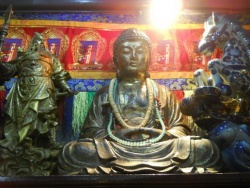Abhidhamma
Abhidhamma is a particular approach to the Dhamma which began to develop during the Buddha's time and reached its final form some two or three centuries after his passing. The word abhidhamma means `pertaining to dhammas.' Abhidhamma developed when early Buddhist thinkers tried to analyse phenomena into their most basic units which they called dhammas and then attempted to describe their characteristics, their duration, their interaction with one another and their kammic results. Whereas the Buddha generally restricted himself to empirical experience, abhidhamma tends to be more speculative.
Abhidharma
阿毘達磨 (Skt; Pali Abhidhamma; Jpn abidatsuma )
Doctrinal treatise and commentary. One of the three divisions of the Buddhist Canon, the other two being sutras and Vinaya (rules of monastic discipline). Dharma means the Law or The Buddha's teachings, and abhi literally means to, toward, or upon. Abhidharma means "upon the Law" and refers to commentaries on the Law, that is, doctrinal studies of The Buddha's teachings' or the sutras. Between the fourth and the first centuries B.C.E., schisms arose repeatedly within the Buddhist Order, resulting in the formation of twenty schools. Many of those schools worked out their own doctrinal systematization of the sutras, and these were included in the Abhidharma.The Sarvastivada school, the most influential of the Hinayana schools, produced a number of Abhidharma works. Among these,
The Treatise on the Source of Wisdom, written by Katyayaniputra in the second century B.C.E., contributed greatly to the development of Sarvastivada Thought and formed the basis for further studies. Some two hundred years later, a voluminous commentary on The Treatise on the Source of Wisdom called The Great Commentary on the Abhidharma was completed. the Dharma Analysis Treasury, by Vasubandhu (fourth or fifth century), is often regarded as the pinnacle of Abhidharma literature because it explains the contents of the above two works, reexamines traditional Sarvastivada doctrines, and cites the studies of a number of other schools; it is therefore an invaluable reference for the study of the Abhidharma in general. Very few Sanskrit Abhidharma manuscripts are extant; most are known through their Chinese translations. The present Theravada school of Southern Buddhism has a collection of seven Pali works that comprise the abhi Dharma of this school.
Abhidharma school
毘曇宗 (Skt; Chin P’i-t’an-tsung; Jpn Bidon-shu)
Also known as the P'i-t'an school. One of the so-called thirteen schools of Chinese Buddhism, the Abhidharma school prospered in northern China during the Northern and Southern Dynasties period (439-589). It based its teachings on Abhidharma works such as Dharmashri's Heart of the Abhidharma and Dharmatrata's Supplement to "The Heart of the Abhidharma." Hence the name of the Abhidharma school.
P'i-t'an is the Chinese transliteration of Abhidharma. The Sanskrit term Abhidharma means doctrinal commentary, one of the three divisions of the Buddhist Canon, the other two being sutras and Vinaya (rules of monastic discipline). The twenty Hinayana schools in India, particularly the Sarvastivada, produced Abhidharma works. During the Northern and Southern Dynasties period in China, they were regarded as essential references on Buddhist Doctrine. Later in the seventh century, when Hsüan-tsang translated the Dharma Analysis Treasury, The Great Commentary on the Abhidharma, and other Abhidharma works into Chinese, the Dharma Analysis Treasury (Chy-she) school absorbed the rapidly declining Abhidharma school.
Dharma Analysis Treasury, The
阿毘達磨倶舎論 (Skt Abhidharma-kosha-bhashya or Abhidharmakosha-shastra; Chin A-p’i-ta-mo-chy-she-lun; Jpn Abidatsuma-kusha-ron )
Also known as Abhidharmakosha. An exhaustive study of the Sarvastivada Abhidharma, written by Vasubandhu (fourth or fifth century) and translated into Chinese in 651 by Hsüan-tsang. A Sanskrit manuscript is extant. There is another Chinese translation, done by Paramartha in 564, as well as a Tibetan translation. As a systematic explanation of Buddhist ideas and concepts, the Dharma Analysis Treasury includes a comprehensive discussion of Buddhist themes organized in nine chapters:
(1) "Elements" (or dharmas),
(2) "Sense Organs,"
(3) "Realms,"
(4) "Actions,"
(5) "Earthly Desires,"
(6) "Stages of Worthies and Sages,"
(7) "Wisdom,"
(8) "Meditation," and
(9) "Refutation of the Idea of the Self."
The first two chapters are a categorization of the dharmas, or elements of existence, and their functions.
The third through the fifth chapter elaborate on the realms of Delusion. Among these, the third chapter describes the Buddhist view of the Universe, including the concept of transmigration within the realms of Delusion.
The fourth chapter outlines the actions that cause one to fall into the realms of Delusion.
The fifth chapter explains that earthly desires and illusions produce actions that in turn bring about Suffering in the realms of Delusion. Here, earthly desires are divided into two categories: fundamental and derivative. The following three chapters, from the sixth to the eighth, clarify the way to Enlightenment.
The sixth chapter explains the stages through which voice-hearers advance toward the level of Arhat.
The seventh chapter deals with the Wisdom that leads one to Enlightenment.
Two kinds of Wisdom are defined:
Wisdom that continues to be bound by earthly desires and Wisdom that is free from earthly desires.
The eighth chapter discusses the practice of Meditation that brings forth Wisdom that is untainted by earthly desires.
The ninth and last chapter discusses the Doctrine of nonself, refuting the idea of the self.This work is primarily a critical analysis of The Great Commentary on the Abhidharma, the principal text of the Sarvastivada school, one of the major early Indian schools of Buddhism. In the Dharma Analysis Treasury, Vasubandhu, originally a Sarvastivadin, reexamined traditional Sarvastivada teachings from a broader standpoint, drawing on the interpretations of several schools, most notably those of the Sautrantikas. In response, Samghabhadra wrote The Treatise on Accordance with the Correct Doctrine to refute the ideas of the Dharma Analysis Treasury and exalt the traditional Sarvastivada Doctrine.
the Dharma Analysis Treasury itself contains an excellent and thorough exposition on Sarvastivada Doctrine and forms a unified doctrinal system, and has been regarded as a textbook of the Sarvastivada school. A pinnacle of doctrinal study, the Dharma Analysis Treasury greatly influenced people's understanding of Buddhism in later ages and was studied widely in India, China, and Japan. Consequently, a number of commentaries on it were produced, and the Dharma Analysis Treasury (Chin Chy-she; Jpn Kusha) school was founded in China based on this work. The school was brought to Japan and became known as one of the six schools of Nara.
Great Commentary on the Abhidharma, The
阿毘達磨大毘婆沙論 (Skt Abhidharma-mahavibhasha-shastra; Chin A-p’i-ta-mo-ta-p’i-p’o-sha-lun; Jpn Abidatsuma-daibibasha-ron )
An exhaustive commentary on the Hinayana doctrines. This work was compiled in Kashmir in the former half of the second century. According to tradition, the compilation was carried out by five hundred Arhats under the guidance of Parshva and the support of King Kanishka at the time of the Fourth Buddhist Council; the compilation took twelve years. This two-hundred-volume work is a commentary on Katyayaniputra's Treatise on the Source of Wisdom, the basic doctrinal text of the Sarvastivada school, and was translated into Chinese by Hsüan-tsang in the mid-seventh century.
There is another Chinese translation, which is the sixty-volume Commentary on the Abhidharma, made by Buddhavarman and Tao-t'ai of the Northern Liang dynasty (397-439). This work corresponds to the first half of The Great Commentary on the Abhidharma. The Great Commentary on the Abhidharma sets forth the Doctrine of the conservative Sarvastivada school of Kashmir and refutes the positions of the more progressive Gandhara Sarvastivada school, the Mahasamghika school, the non-Buddhist Samkhya school, and other non-Buddhist schools. It serves as a record of the doctrinal development of the Sarvastivada school from the time of the Writing of The Treatise on the Source of Wisdom. This work systematized the Sarvastivada Doctrine; however, because it was so voluminous, it later prompted the compilation of a condensed version, The Heart of the Abhidharma.
Heart of the Abhidharma, The
阿毘曇心論 (Skt Abhidharma-hridaya-shastra; Chin A-p’i-t’an-hsin-lun; Jpn Abidon-shin-ron )
A 250-verse compendium of the Abhidharma Doctrine of the Sarvastivada school, written in the third century by Dharmashri (also known as Dharmashreshthin) and translated into Chinese in 384 by Samghadeva. Dharmashri, a scholar of the Sarvastivada school, was from the Tukhara kingdom. The Heart of the Abhidharma is an abridgment of the doctrinal teachings contained in the massive Great Commentary on the Abhidharma, one of the basic texts of the Sarvastivadins. The Sarvastivada school first compiled The Treatise on the Source of Wisdom and six other doctrinal texts to clarify its fundamental tenets, and later produced The Great Commentary on the Abhidharma as a comprehensive survey and compilation of studies concerning its Doctrine. The production of The Heart of the Abhidharma followed.
The title of the third (and last) group, or pitaka, of the Buddhist canonical books ; a name also for the specific way in which the Dhamma (doctrine) is set forth in those books. It is in that specific treatment, and not in any distinctive subject-matter, that the real use and significance of these books for early Buddhism are to be found. A myth grew up among 19th cent. Indologists, that the Abhidhamma pitaka was the repository of Buddhist metaphysie.
Acquaintance with the contents of the pitaka has dispelled this notion. There is, no doubt, an abstruse and abstract, suggestiveness in the titles and opening sentences of the books and their divisions, giving a fictitious suggestion of originality and profundity. But, besides this, there is an ancient tradition of superior erudition and higher standing attaching to those of the Buddhist order who were Abhidhammikas, or experts in Abhidhamma.
Thus, in the Mihintale rock inscription, dating from about the commencement of our Middle Ages, tithes from 12 villages or farms are allotted to the cave-recluses there who were Abhidhammikas, as against tithes from 7 and 5 respectively allotted to experts in Suttanta and Vinaya (that is, in the Doctrine and in the Rules of the Order).
And whereas mastery of these two was held to establish the expert in sila and samadhi respectively (that is, in conduct and meditation), knowledge of Abhidhamma involved the development of panna, — constructive imagination and comprehension, — which ranked among the highest virtues. Once more, in the ancient book translated as The Questions of King Milinda, the acquisition by the youthful genius Nagasena of the contents of the Abhidhamma is acclaimed with wonder and delight in earth and heaven, while his rapid attainment of the remaining pitakas excites no such commotion. Finally, the title itself may have helped to mislead Western, and even Eastern notions.
Abhi can mean sur, super, and hence suggests an analogy with Aristotle's Physics and Metaphysics. Buddhaghosa himself, in explaining the title, gives ati (' beyond,' ' above,' ' to excess ') as the equivalent of the prefix, in as much as Abhidhamma goes beyond the Dhamma, and is distinct from it.
But he proceeds to explain that this distinction is due, not to any superior profundity of method, or nature of subject-matter, but to the more detailed analysis given to points of doctrine in the Abhidhamma as compared with the Suttanta methods. There was a legend in his day that the Abhidhamma was first uttered by the Buddha in the Tavatimsa heaven, whither he had transported himself to preach the Dhamma to his deified mother and hosts of devas.
It is not consonant with the Buddhist standpoint, that such an audience should be held capable of benefiting by disquisitions on philosophical problems which had been withheld from the stronger intellects of the Buddha's chief disciples, whom he instructs in the Suttanta. In fact, the legend sprang probably from the orthodox anxiety to invest with a sanction, not inferior to that of the two earlier pitakas, a series of compilations which are manifestly of later date, and the work of elaborating scholiasts.
Let it, then, be clearly understood that our present knowledge of such philosophy as is revealed in the Buddhist Pali canon would be practically undiminished if the whole of the Abnidhamma pitaka were non-existent. That philosophy is all to be found in the Sutta pitaka. The ADhidhammika may nevertheless be held to have surpassed his Suttantika confrire in two ways.
It should always be remembered (and the usually wearisome form of the Abhidhamma books never lets the reader forget it) that the canon was compiled, and for generations learnt, as an unwritten composition. In the first two pitakas the memory is aided by episodes giving occasion for the utterance of rule, doctrine, or discussion, and also by frequent verse.
The Abhidhamma gives no such aids. It helps only by catechism ; in its last and longest books, not even by that. Hence the call for sus- tained reconstructive and reproductive effort must have been more severe. And, further, since the work is mainly a recount, with analysis and elaborations and comment, of Suttanta doctrines, to know one's Abhidhamma might be said to involve a knowledge of the gist of the Sutta pitaka.
The burden, then, of Abhidhamma is not any positive contribution to the philosophy of early Buddhism, but analytic and logical and methodological elaboration of what is already given. As such it might have almost equalled, in value to the world, the contents of the discourses. As a fact it is the reductio ad absurdum of formalism.
It is impossible to estimate the extent to which the exaggeration of the Indian temperament and the temperance of the Greek temperament were due to the absence and presence respectively, during the florescence of each, of the written book. No- where as in India do we find imagination so elastic and exuberant, running riot through time, space, and the infinite ; and nowhere else is seen such determined effort to curb and regulate it. Abhidhamma training was one of the most note- worthy forms of this effort.
It was specially calculated (according to Buddhaghosa, A tthasdlini, p. 24) to check those excesses over the normal mind (dhammachitta) which, in the Buddha's words, tended to loss of balance, craziness, and insanity. The chief methods of that training were : first, the definition and determination of all names or terms entering into the Buddhist scheme of culture ; secondly, the enunciation of all doctrines, theoretical and practical, as formulas, with co-ordination of all such as were logically interrelated ; and finally, practice in reducing all possible heterodox
Eositions to an absurdity — a method which is con- ned to the somewhat later fifth book, the Kathavatthu. Even in these lofty aims, however, the want of restraint, helped by the cumbrousness of purely mnemonic compilation, tends to defeat the very objects sought. The logic of definition is not the same as we have inherited, and the propositions yield strings of alternatives that have often little or no relation to facts.
Of the seven books of the Abhidhamma pitaka, the first five have been published by the Pali Text Society, viz. Dhammasaiigani, Vibhanga, Dhdtukathd, Puggala-paflfiatti&nd Rathavatthu ; the sixth, or Yamaha, is not yet edited ; the seventh, the Patthana, is [1907] in the press. The first book has been trans- lated by the present writer under the title, A Buddhist Manual of Psychological Ethics, London, 1900.
Besides these seven, there still survive, in Chinese or Tibetan translations, other seven books, which form the Abhidhamma literature of the SarvSstivadins — a school which split off from the original nucleus of Buddhist culture. A very full index to the contents of these seven is given by Professor Takakusu in JPTS, 1905. But the books themselves have not as yet been edited or translated. Their date also is not yet settled, but they are certainly earlier than the Christian era.
These works form the basis of the celebrated, but as yet undiscovered, Abhidharmakosha, or Dictionary of Abhidhamma, written in Sanskrit, as well as that of its Commentaries, and other cognate works, some of which survive in Sanskrit and others in Chinese or Tibetan versions, and which carried on the development of Abhidhamma down to the 2nd or 3rd cent. a.d.
Professor Bunyiu Nanjio, in his catalogue of Chinese Buddhist literature (Oxford, 1883), gives the titles of no fewer than thirty-seven of these works still extant. In the later developments of Buddhism in India, notably in the so-called 'Great Vehicle,' the use of the term Abhidhamma gradually died out. But in other Buddhist countries, where Pali has remained the literary language, books on Abhidhamma have continued to be written down to the present day, the best known being the Abhidhammatthasangaha, published in 1884 by the Pah Text Society.
C. Rhys Davids.





